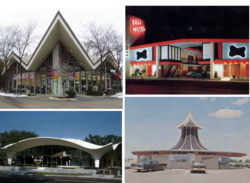


Googie (goo-ghee) is a specific genre of Modernism that features striking angularity, upswept roofs, spaceship forms, starburst motifs, atomic model-like shapes, and parabolic curves. The style reflects a post-war fascination with jet-age futurism, evolving in the 1950s and ’60s.
Architectural historian Alan Hess has studied the movement extensively and reflects that “one of the key things about Googie architecture was that it wasn’t custom houses for wealthy people—it was for coffee shops, gas stations, car washes, banks… the average buildings of everyday life that people of that period used and lived in… and it brought that spirit of the modern age to their daily lives.”
The term “Googie” was coined by an architectural critic who saw a markedly futuristic coffee shop on LA’s Sunset Strip and used the name of the establishment to pejoratively describe the style. Googie’s Coffee was designed in 1949 by architect John Lautner (1911-1994). The building, sadly now demolished, featured a vivid banded roof that twisted upwards to form a dramatic, high-visibility advertising sign, a nod to post-war mobility and the culture of the automobile which required buildings to attract the attention of fast-moving passersby. In an interesting connection to Michigan, John Lautner was born and raised in Marquette and attended Northern Michigan University. Lautner apprenticed under Frank Lloyd Wright at his Taliesin Fellowship for several years. Lautner’s work with Frank Lloyd Wright eventually led him to California, where he practiced for the remainder of his career.

Even though Googie Architecture is frequently associated with the west coast, there are some notable examples still standing in Michigan. One easy-to-spot example is the Dawn Donut building (currently a pizza shop) located at 1135 E. Grand River Avenue in East Lansing. The small building features a dramatic folded roof form that sweeps upwards to form three steep, glass-enclosed pitches.
Another striking Googie building is Stanley Hong’s Mannia Café located in Detroit on Baltimore east of Woodward Avenue. The restaurant was designed in 1969 by architect Nathan Johnson (1925-2021). Johnson was a trailblazer, not only as a preeminent designer but as one of the first African American architects to form his own architectural practice in the city of Detroit in the 1950s. The structure still stands, although it is in poor physical condition. Despite this, the building’s form is stunning as the sweeping arcs of the undulating roof seemingly collide at the corner of the structure to create a dramatic spire. The pinnacle both marks the building’s entrance and creates crucial signage for the building. The restaurant flourished through the 70s and later became a part of Detroit’s early hip-hop music scene. Stanley Hong’s place in Detroit’s history has been secured by the recent creation of a historic district and a redevelopment effort to preserve it.
Googie modernism can be seen all over the architecture of everyday buildings: bowling alleys, motels, drive-ins, and cafes. Even though the movement was originally castigated as something “less” the style now conjures the optimism of the post-war US, where the possibilities seemed limitless and the future bright.